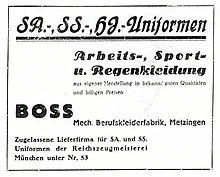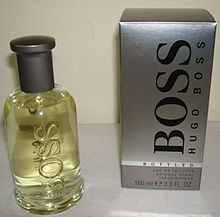User:Dy1971/sandbox
{Use mdy dates|date=May 2011}}
 | |
| Company type | Aktiengesellschaft |
|---|---|
| FWB: BOSS | |
| Industry | Apparels, accessories |
| Founded | 1924 |
| Headquarters | , Germany |
Key people | Claus-Dietrich Lahrs (CEO and chairman of the managing board), Hellmut Albrecht (Chairman of the supervisory board) |
| Products | High fashion clothing, accessories, footwear |
| Revenue | €1.729 billion (2010)[1] |
| €263.9 million (2010)[1] | |
| €185.9 million (2010)[1] | |
| Total assets | €1.355 billion (end 2010)[1] |
| Total equity | €361.2 million (end 2010)[1] |
Number of employees | 9,940 (end 2010)[1] |
| Parent | Red & Black Holding GmbH (56%) MDAX (42%) |
| Website | hugoboss.com |
This article may require copy editing for grammar, style, cohesion, tone, or spelling. (November 2013) |
Hugo Boss AG is a German luxury fashion and style house based in Metzingen, Germany. It is named after its founder, Hugo Boss (1885–1948).
History[edit]
This section is empty. You can help by adding to it. (January 2014) |
Foundation[edit]

In 1924, Hugo Boss started his clothing company in Metzingen, a small town south of Stuttgart, where it is still based. Due to the economic climate in Germany at the time, Boss was forced into bankruptcy. In 1931, he reached an agreement with his creditors, leaving him with six sewing machines to start again.
Supplier to the Nazi Party[edit]
The same year, he became a member of the National Socialist (Nazi) party and a sponsoring member ("Förderndes Mitglied") of the Schutzstaffel (SS).His economic situation improved with their help. He later stated that he had joined the party because of their promise to end unemployment ,and because he felt "temporarily" withdrawn from the Lutheran church. He joined the German Labour Front in 1936 ,the Reich Air Protection Association in 1939, and the National Socialist People's Welfare in 1941. His sales increased from 38,260 RM in 1932 to over 3,300,000 RM in 1941, while his profits increased in the same period from 5,000 RM to 241,000 RM. Though he claimed in a 1934/1935 advertisement that he had been a "supplier for National Socialist uniforms since 1924". He probably began to supply since 1928/1929. Since 1934, he became an Reichszeugmeisterei-licensed (official) supplier of uniforms to the Sturmabteilung, Schutzstaffel, Hitler Youth, National Socialist Motor Corps, and other party organizations. To meet demand in later years of the war, Boss used about 30 to 40 prisoners of war, and about 150 forced (i.e. slave) labourers from the Baltic States, Belgium, France, Italy, Austria, Poland, Czechoslovakia, and the Soviet Union.[2] According to German historian Henning Kober, the company managers were "avowed Nazis", who were "the Boss were all great admirers of Adolf Hitler". Also, Hugo Boss had a photograph in his apartment, which was taken with Hitler in the latter's Obersalzberg retreat in 1945.[3]
Post WW2 repercussions[edit]
In a 1946 judgment, Boss was considered both an "activist" and a "supporter and beneficiary of National Socialism" ,because of his early party membership, his financial support of the SS and the uniforms he delivered to the Nazi party. Therefore, he was stripped of his voting rights and his capacity to run a business, and fined "a very heavy penalty" of 100,000 Deutschmarks.[2] He died in 1948, but his business survived.
In 1997, the company appeared in a list of Swiss dormant accounts in connection with reparations lawsuits, which stirred the publication of articles highlighting the involvement of Hugo Boss with the Nazis.[4][5][6] In 1999, American lawyers filed lawsuits in New Jersey on behalf of survivors or their families for the use of forced workers during the war.[7][8] The company did not comment on these lawsuits but reiterated an earlier statement that it would "not close its eyes to the past but rather deal with the issues in an open and forthright manner".[7] a In order to do so, it sponsored research by German historian Elisabeth Timm.[2] Nevertheless, after Timm told the press of her findings, the company declined to publish them.[9] In December 1999, an agreement was reached between the German government and the United States government with groups of American and Jewish class-action lawyers to set a $5.1 billion fund. The fund was financed equally by German industry and the German government, to compensate slave laborers used by the Germans in World War II.[10] Hugo Boss agreed to participate in this fund,[11] for an amount which was estimated by some sources to be "about € 752 000".[12]
1950s-1990s[edit]

As a result of the ban on his being in business, Boss's son-in-law Eugen Holy took over the ownership and running of the company. In 1950, the company received its first order for men's suits after a period supplying work uniforms, resulting in an expansion to 150 employees by the end of the year. By 1960 the company was producing off-the-peg suits. In 1969, Eugen retired and left the running of the firm to his sons Jochen and Uwe, who began the international development. In 1970, the first Boss branded suits were produced,with a trademark which is registered in 1977. This was followed by the start of the company's long association with motorsport, sponsoring Formula1 driver Nikki Lauda, and later the McLaren Racing team.
In 1984, the first Boss branded fragrance appeared, which helped the company gained the required growth spurt for the company to list on the Frankfurt Stock Exchange the following year. It entered the world of golf by sponsoring Bernhard Langer in 1986, and entered the world of tennis by sponsoring the Davis Cup in 1987. In 1989,the company launched its first licensed sunglasses. In the same year, the company was bought by a Japanese group.[14]
After the Marzotto textile group acquired a 77.5% stake for $165 million in 1991,[14][15] the Hugo and Baldessarini brands were introduced in 1993. In 1995 the company launched its footwear range, the first in a now fully developed leather products range across all sub-brands. A partnership with the Solomon R. Guggenheim Foundation was launched in 1995, resulting in the Hugo Boss Prize, an annual $100,000 stipend in modern arts presented since 1996. In the same year, the first license was agreed for the launch of the Boss Black watch range.
In 1991, the Marzotto textile group acquired a 77.5% stake for $165 million.[14][15] Marzotto spun off its fashion brands into the newly created Valentino Fashion Group in 2005, which is sold to Permira private equity group in 2007. Permira owns its majority shareholding in the Hugo Boss Group via Red & Black Holding GmbH (56%), with 42% of the shares floated on MDAX and the residual 2% held by the company itself.
2000-2010[edit]

Hugo Boss has at least 6,102 points of sale in 124 countries. Hugo Boss AG directly owns over 364 retail stores, has 537 monobrand retail stores, and over 1,000 stores and shops owned by franchisees.[14]
Products are manufactured in a variety of locations, including the company's own production sites in: Metzingen, Germany; Morrovalle, Italy; Mid Valley City, Kuala Lumpur, Malaysia; Radom, Poland; Izmir, Turkey; and Cleveland, United States.[16] There are two core brands, Boss and Hugo:
- Boss Black. Menswear (1970), womenswear (2000). Modern classic clothing which is more widely distributed than other lines, and has the broadest product range.
- Boss Orange. Menswear (1999), womenswear (2005). Originally quirky styling, with bohemian influences, this line was relaunched in 2010 as denim based casual wear.
- Boss Selection. Menswear (2003). Higher priced clothing aimed at a more mature market, with emphasis on English tailoring styles.
- Boss Green. Menswear (2003), womenswear (2010). Previously known as Boss Sport, was relaunched in 2003 as a golf-style active wear collection.
- Hugo. Menswear (1993), womenswear (1998). Fashion forward styling, with a more European look, and sometimes androgynous models.
Hugo Boss has licensing agreements with various companies to produce Hugo Boss branded products. These include agreements with Samsung and HTC to produce cell phones; C.W.F. Children Worldwide Fashion SAS to produce children's clothing; Shiseido and Procter & Gamble Prestige to produce fragrances and skincare;[17] Movado to produce watches;[18] and Safilo to produce sunglasses and eyewear.[19]
In 2009, BOSS Black was by far the largest segment, consisting 68% of all sales.The remainder was made up by BOSS Orange (17%), BOSS Selection (3%), BOSS Green (3%) and HUGO (9%). Sales taken in company owned stores were 19% of total sales worldwide.[20]
2010-present[edit]
In 2010, the company has sales of €1.7 billion and a net profit of €190 million,[14] with royalties of 78 million or 42% of total net profit.[14]
In March 2010, Hugo Boss was boycotted by actor Danny Glover for the company's plans to close an Ohio suit manufacturing plant after 375 employees of the Workers United Union reportedly rejected Hugo Boss proposal to cut the workers' hourly wage 36% from $13 an hour to $8.30.[21] After CFO Andreas Stockert stated that the company had a responsibility to shareholders and would move suit manufacturing from Ohio to other facilities in Turkey, Bulgaria, and Romania,[22] the company consequently capitulated to the boycott and cancelled the project.[23]
See also[edit]
References[edit]
- ^ a b c d e f "Annual Report 210" (PDF). Hugo Boss. Retrieved May 5, 2011.
- ^ a b c Timm, Elisabeth (April 18, 1999). "Hugo Ferdinand Boss (1885–1948) und die Firma Hugo Boss" (PDF). Metzingen Zwangsarbeit (in German). Retrieved December 31, 2010.
- ^ Kober, Henning (July 29, 2001). "Über den Umgang mit Zwangsarbeiterinnen bei Boss". Metzinger Zwangsarbeit (in German). Retrieved January 1, 2011.
- ^ Givhan, Robin (August 14, 1997). "Hugo Boss Factory Made Nazi Uniforms". The Washington Post. Retrieved January 2, 2011.
- ^ "Hugo Boss Acknowledges Link to Nazi Regime". The New York Times. August 14, 1997. Retrieved September 29, 2008.
- ^ White, Constance C. R (August 19, 1997). "Patterns: The Fallout on Hugo Boss". The New York Times. Retrieved January 1, 2011.
- ^ a b "Hugo Boss 'used slaves to work for Nazis'; Charge by Holocaust Survivors". The Daily Mail. May 15, 1999. Retrieved January 1, 2011.
- ^ Bazyler, Michael (2005). Holocaust Justice: The Battle for Restitution in America's Courts. NYU Press. p. 65. ISBN 978-0-8147-9904-8. Retrieved January 2, 2011.
- ^ Bourdoiseau, Christophe (June 23, 2000). "Les habits nazis de Hugo Boss". Le Point (in French). Retrieved January 1, 2011.
- ^ Andrews, Edmund L. (December 18, 1999). "Germany Accepts $5.1 billion Accord to End Claims of Nazi Slave Workers". The New York Times. Retrieved January 2, 2011.
- ^ "German Companies Participating in the Forced/Slave Labor". Jewish Virtual Library. July 8, 2000. Retrieved January 3, 2011.
- ^ Kober, Henning (June 18, 2002). "Besuch beim Boss". Taz (in German). Retrieved January 2, 2011.
- ^ "Boss Bottled (1988)". Basenotes. Retrieved January 7, 2012.
- ^ a b c d e f Chevalier, Michel (2012). Luxury Brand Management. Singapore: John Wiley & Sons. ISBN 978-1-118-17176-9.
- ^ a b "Marzotto S.p.A." The New York Times. November 2, 1991. Retrieved January 1, 2011.
- ^ "HUGO BOSS AG Organisational Structure". Hugo Boss AG. Retrieved February 13, 2011.
- ^ "PG.com HUGO BOSS: fragrances, contemporary design, design competition". Retrieved February 13, 2011.
- ^ "Movado Group Inc". Retrieved February 13, 2011.
- ^ "Safilo Group S.p.A/". Retrieved February 13, 2011.
- ^ "Results of Operations in Fiscal Year 2009". Hugo Boss AG. Retrieved February 13, 2011.
- ^ Glover, Danny (March 7, 2010). "Glover: Help Ohio Plant, Shun Hugo Boss At Oscars". Associated Press. Retrieved January 1, 2011.
- ^ Boss to move US factory production to Romania, Bulgaria, Turkey, trade union says
- ^ Covert, James (April 24, 2010). "Stars' factory crusade shows Hugo who's 'Boss'". the New York Post. Retrieved January 1, 2011.
External links[edit]
Category:Companies established in 1924
Category:Clothing brands of Germany
Category:Companies based in Baden-Württemberg
Category:Germany home front during World War II
Category:Underwear brands
Category:High fashion brands
Category:Fragrances
Category:Suit makers
Category:Luxury brands

